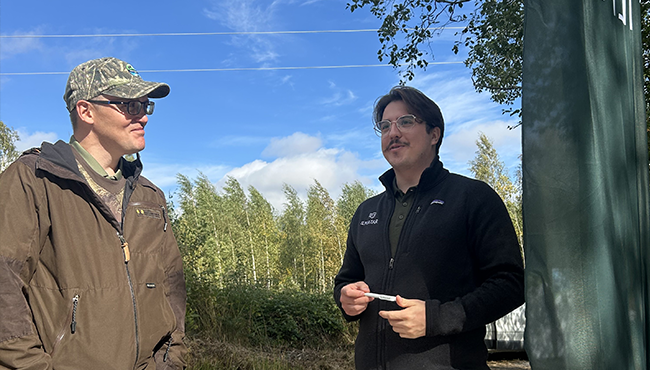At a recent field day in Ylistaro, South Ostrobothnia, the local community showed great interest in how land under power lines could be used more effectively. Ilmatar’s Marko Penttilä and Kiia Kanerva received a warm welcome at the event. Ilmatar’s Ooperi wind power project, currently under development, is located just over ten kilometres from the event site.
A wind farm is connected to the national grid via a connection point. The transmission lines required for this may cross private land and thus influence how the land can be used.
“However, a power line does not prevent the landowner from using the area beneath it, even if it creates certain restrictions. The purpose of this event is to find the best ways to utilise this land – in ways that benefit both the landowner and biodiversity,” says Marko Penttilä, Project Development Manager at Ilmatar.
The project focuses especially on supporting landowners in developing new uses for the areas beneath transmission lines – whether for economic, recreational, or biodiversity purposes. According to material produced by the Forest Centre, potential economic uses include cultivating special crops such as blueberries, sea buckthorn, and Christmas trees, as well as producing birch leaves and spruce shoots. Edge forests could be used for tapping sap and resin, or for growing medicinal fungi.
The open space beneath the lines could be developed for recreation, for example by building hunting towers or routes for biking, hiking, snowmobiling, or ATVs. Open areas also support biodiversity when used for wetlands or wildlife fields and can host beehives to support pollinators.
Dialogue for mutual understanding and sustainable energy production
“The landowners present were very interested in the timetable for building the wind farm, and we had many constructive discussions about the local opportunities of renewable energy. It was also inspiring to meet children and young people interested in wind power. Their high level of knowledge about climate change was a delightful surprise,” Kanerva says.
“Both forest owners and wind power developers want to find ways to reconcile the needs of both industries. By strengthening dialogue, understanding and respect between the parties will grow, which makes cooperation smoother. It was great to see so many local people at the event and to have the chance to discuss this important topic with them,” Penttilä adds.
Penttilä and Kanerva continue developing the Ooperi project. The current focus is on the zoning proposal, which is planned to be made available for public review by the end of the year. Good cooperation supports the green transition and climate goals, enabling renewable energy production and sustainable forestry to progress hand in hand.





